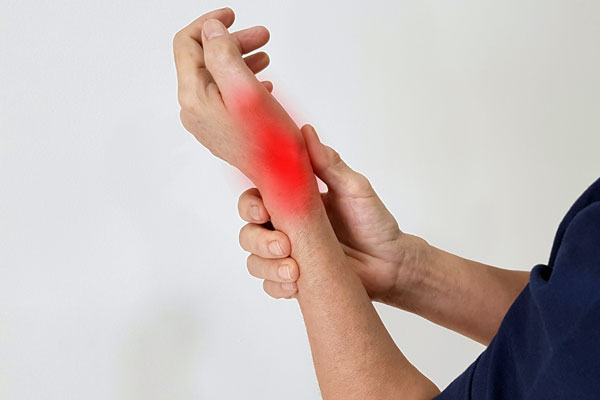De Quervain's tenosynovitis (painful wrist condition)
Indian mythology always provokes deep thoughts, and every string of words leaves us with a complex range of interpretations. One such story is from The Mahabharata, The Ekalavya, which is again quite touching. He offered the thumb of his right hand as a fee (Gurudhakshina) to his worshiped guru, even after knowing that he could not perform archery without it. Not only archery, but the majority of our regular activities involve our thumb.
DeQuervain's tenosynovitis is a painful condition that affects the functionality of our wrist and thumb due to the swelling of the tendons. Tendons are fibrous tissues that attach the muscles to the bone. Actions like gripping, grasping, pinching, or writing involve the movement of the tendons present in the wrist and lower thumb to glide smoothly through a small tunnel that connects them to the base of the thumb. Repetitive activities cause swelling in these tendons, which in turn leads to inflammation of the sheaths covering them. This can restrict their movement and also lead to pain and numbness in the affected region due to increased pressure on the surrounding nerves. In some patients, the severity may be severe enough to affect their activities of daily living.

What are the symptoms of de Quervain's tenosynovitis?
The typical symptoms of de Quervain's tenosynovitis are pain and tenderness at the bottom of the thumb. The discomfort may begin quickly, but it typically comes on gradually and may get worse over time. Sometimes the pain may also radiate to the back of your forearm or thumb. Repetitive activities involving your wrists, hands, or thumbs may aggravate the symptoms.
Other symptoms may include:
- Swelling at the base of your thumb or on the side of your wrist
- Numbness on the back of your thumb and index finger
- Difficulty in moving your thumb or wrist (especially grasping or pinching)
- A squeaking sound while your tendons move in the swollen sheaths
- Formation of fluid-filled cysts at the swollen region
What are the causes of de Quervain's tenosynovitis?
The common cause of de Quervain's tenosynovitis is chronic overuse. Performing activities that involve repetitive movements can lead to irritation and pain. Some of the common movements that cause the condition include lifting a heavy grocery bag by its handles or lifting a child.
The following elements may raise your risk of contracting the illness:
- Aged above 40
- Being a woman
- Injury or trauma to your wrist
- Inflammatory arthritis
- Pregnancy
- Engaging in certain games or activities that require repetitive movements
How is de Quervain's tenosynovitis diagnosed?
The diagnosis usually involves examining your hand to check if you develop pain when pressure is applied on the thumb side of the wrist. A simple test known as the Finkelstein test is useful in determining the condition; it involves bending your thumb across the palm of your hand and bending your fingers down, closing your fingers to make a fist. Later, bend your wrist toward your little finger. In this position, your tendons are stretched, and if this action creates pain on the thumb side of your wrist, you are likely to have de Quervain's tenosynovitis.
What is the treatment approach for de Quervain's tenosynovitis?
The primary goal of the treatment is to provide relief from the pain caused by irritation and swelling. There are numerous methods for treating the symptoms. Some of them include:
Rest: Giving your thumb ample rest is crucial, as sometimes the symptoms may go away on their own while under rest. Continuing the activities that involve your thumb can further aggravate inflammation and pain.
Ice: Applying ice to the affected area also helps in providing relief.
Splint: You can use splints that extend over your thumb and wrist to restrict their movement and provide rest. Some doctors may suggest using them continuously for four to six months, while others may recommend wearing them only as required (during pain).
Medications: Oral administration of drugs such as non-steroidal anti-inflammatory drugs (NSAIDs) helps provide relief from inflammation.
Injections: If there is no considerable improvement in the condition, the physician may recommend steroid injections (corticosteroids) directly injected into the tendon sheath. The majority of people experience reduced swelling and better recovery after receiving injections.
Surgery: When all the above options fail to provide relief or when the symptoms are severe, surgery may be recommended. It involves excising the sheath that surrounds your tendons and opening it to release pressure on the tendons or to create space for them to glide freely.
Consulting a physical therapist post-surgery helps ensure a complete recovery. He may suggest muscle-strengthening exercises for your wrist, arm, and hand. He may also suggest ways to reduce stress on your wrist and alter your activities in order to limit tendon irritation.
Outlook
The outlook for the condition is good with early diagnosis and management. Usually, using a splint and avoiding movements that irritate your tendons helps with management in the majority of cases. If surgery is considered, recovery may take a few weeks. Following stretching and muscle-strengthening exercises with professional advice helps in better recovery and regaining complete functional joints.
